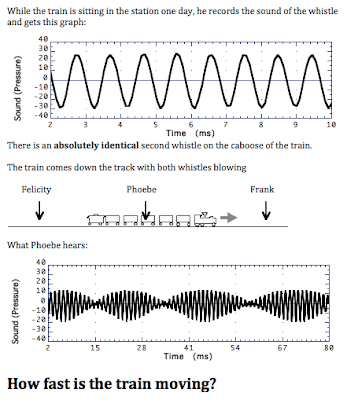The students are getting better at reasoning chains, even as the problems get harder! That's the good news.
Here's the prompt that they worked with last class. This. is. a. hard. one.
...and not just because the time scale on the second pressure vs. time graph is jerky (I'll blame a previous colleague, who put that graph together :) ).
Now, with these problems that I've been posting (here and here, so far), I am giving the students a whiteboard, and they're working in groups. The Coke/Sprite problem was non-curricular, and we were just working with a cool question and looking at reasoning. The Sand/Standing Wave problem was from the just-passed winter final, but I gave it in a stripped-down form, including the given information, but no sub-questions - just the ultimate conclusion that I meant to get them to/ meant them to get to. The same thing is happening here, so don't think that I throw them into the deep end with this problem on the test (though, that's the ultimate goal, isn't it?). I'll talk more about scaffolding during tests in an upcoming post.
Here's my reasoning chain (tree?):
Even though there is a lot of reasoning to be done here, the biggest hurdle by far is the step with the star: the relationship between the Doppler frequency shift and the beat frequency. I gave two different ways that students came up with to reason through this: the left-most one is more mathematical and formal, and the second is more of a conceptual argument. I didn't include the third argument: a graphical one. This one's pretty slick, and was relatively common, though some students still don't believe in the power of diagrams (grrr)!
I love this explanation - it totally encapsulates both of the reasoning boxes that I used in my diagram!
The student chains are all improved from the first two, though many still eschew getting into the nitty-gritty of the reason that the beat frequency is twice the Doppler shift. They figure out (by hook or by crook) the answer, and it's the answer that that captivates them, when it should be the concept and the structure of the argument. Some are really starting to roll with this, though!
The real story:
Who cares what this answer was? You'll never see this problem again! Understanding the principles that we used and how to structure the argument let you solve the next problem!
No fancy math required; accurate thinking essential.






This is totally cool. What I hate about many static work-sheet driven curriculum is that they would try to drag students by the teeth through some of these same chain of reasoning, step-by-step. The total sum of students' worksheet answers integrated together usually amount to nothing. It's only an allusion that students have gone through the reasoning themselves. What you are doing is totally different. Thanks!
ReplyDeleteIt's a hard balance - between supporting and just having them follow the checklist. They're so used to filing in all of the boxes and never thinking about any of it! It's an uphill battle, but they come around (mostly :) ).
ReplyDeleteJosh,
ReplyDeleteDo you have a library of these problems that you've created? I like the idea of a reasoning tree, as opposed to a chain, since it does indicate the productive branching of ideas.
@QP: I don't have a bank of them, other than my tests :) That's where most of these are coming from. I'm thinking about hosting an aggregation of reasoning chain posts, though (a la pseudothis-and-that). What do you think?
ReplyDeleteI think that would be fantastic. During our physics elluminate session last night, we also talked about creating an online database to store physics problems to use for reassessments.
ReplyDelete